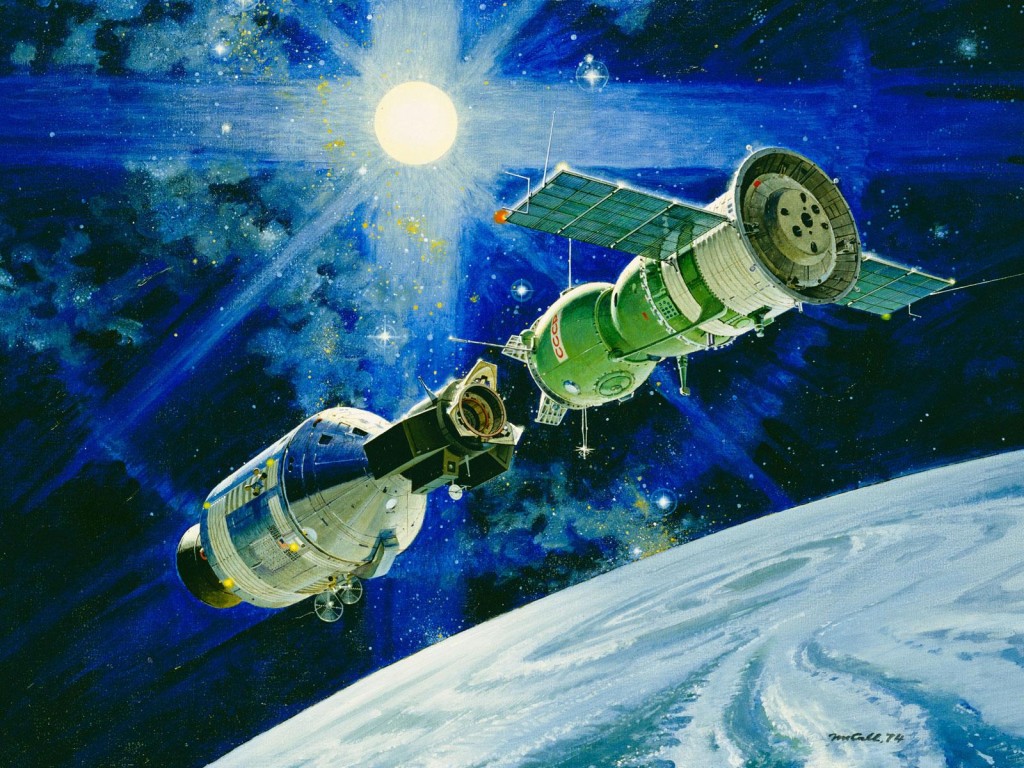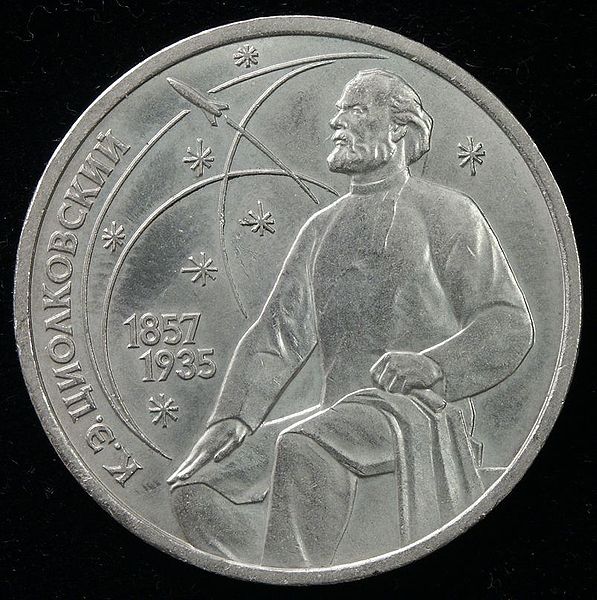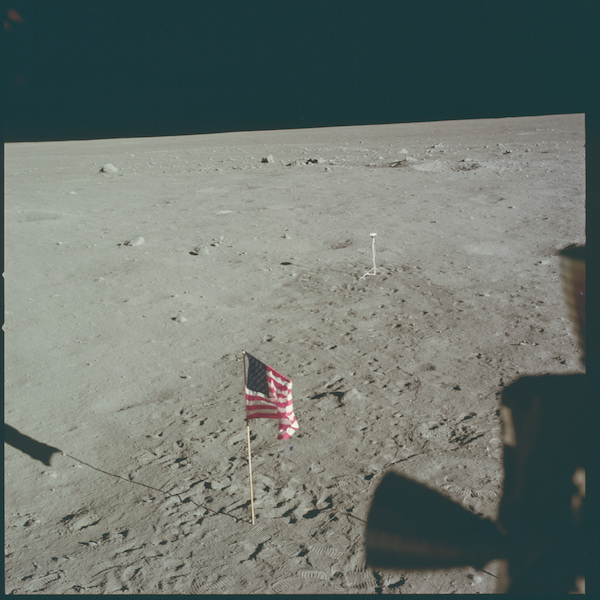The Space Race was a contest of ideologies. Cosmonauts and astronauts played the part of soldiers on a bloodless battlefield, pitting communist and capitalist principles against one another in a fight for intellectual supremacy.
The two sides of the Cold War each developed rationales to explain the importance of space in their nationalistic goals. Soviets could tap into their country’s lengthy record of imagining our future in space, and believed that science and progress would bring about the perfection of humankind. At the same time, Americans relied on an idyllic rendering of the past, with a fortifying frontier that molded its people into rugged individuals.
Each view is flawed, relying on idealizations and simplifications to underpin its reasoning. Yet these dreams remain powerful, and proponents continue to invoke them in modern spaceflight discussions.
The Russian line of thought has contributed to spaceflight’s spiritual side, the idea that liberation from Earth will allow humanity to redeem itself and begin anew. U.S. advocates have provided spaceflight with a mythic framework — in exploring, we better the lands we conquer and ourselves in the process. Under the hood, the explanations are more alike than different. Together, they represent the best we hope to achieve as we make our way toward the heavens.
Spiritual Origins
Human spaceflight begins with Russia. No other modern country has had as long and detailed a history of thinking about our lives among the stars. In the late 19th century, during the waning days of its imperial power, Russia was undergoing rapid industrialization and had a populace hooked on the latest Jules Verne novels from France. From this world emerged a noble-class thinker named Nikolai Fyodorov, the first prophet of spaceflight, espousing a philosophy known as Cosmism.
Much of Fyodorov’s work centered around the idea of resurrection. As a Russian Orthodox Christian, he believed that Christ’s gift of resurrection at the End of Days and everlasting life thereafter was the ultimate incarnation of God’s love. Witnessing the tremendous power of science and engineering at work around him, he foresaw a day when human beings would be like gods and would use their supremacy to reanimate the dead generations of the past.
“The organism is a machine and consciousness relates to it like bile to the liver,” Fyodorov wrote in his Philosophy of the Common Task. “So reassemble the machine and consciousness will return to it.”
According to Fyodorov’s theory, a dead person is essentially a collection of particles that have broken apart. But, if you could bring all those particles back together, a human could once again emerge. The problem is that some of these particles — especially those from our really ancient ancestors — have escaped the Earth and scattered across the universe.
Therefore, Fyodorov wrote, humankind must band together in a common task; launching into space to collect the ashes of the deceased and building off-world habitats to house all our newly resurrected relatives. Using science and technology, we could assume absolute control over irrational nature, placing it under sensible human regulation to prevent anyone from dying ever again. To Fyodorov, this was the only moral way for “the human mob with its mutual push and struggling” to “become a harmonious force.”
Though little known today, Fyodorov’s mystic visions directly influenced many later Russian spaceflight proponents, perhaps none more important than Konstantin Tsiolkovsky. The son of a rural forester and teacher, Tsiolkovsky had grown up in the remote town of Izhevskoye and survived a bout of scarlet fever at age 10 that left him hard of hearing. After falling behind in his studies, he spent three years at the Moscow library, where he met daily with Fyodorov. He later wrote that the elder philosopher “for me took the place of university professors.”
Tsiolkovsky is now known as the patriarch of Russian spaceflight. Working most of his life in obscurity on the outskirts of Kaluga, a city 200 kilometers southwest of Moscow, he drew up designs for space stations, airlocks, life support systems, and multi-stage rockets — the kind that would later carry Apollo astronauts to the moon. In 1898, he wrote a mathematical paper, Investigation of Cosmic Space by Reactive Devices, that introduced the rocket equation, which mathematically describes the movement of vehicles in space.

Due to his reclusive nature and because many believed his ideas to be odd, Tsiolkovsky’s work languished for decades. It was only near the end of his life in the 1930s that the Bolshevik government resurrected Tsiolkovsky’s findings and canonized him among the saints of spaceflight.
But less well-known than his scientific and mathematical treatises are Tsiolkovsky’s philosophical ideas. Much like Fyodorov before him, Tsiolkovsky entertained a messianic philosophy that combined occultism, evolution, and Christianity. “At a fundamental level, Tsiolkovsky was a religious thinker whose life was an attempt to reconcile the scientific views of nature that seemed to contradict his strong faith in Christ,” wrote space historian Asif Siddiqi in The Red Rocket’s Glare: Spaceflight in the Soviet Imagination.
Tsiolkovsky believed that all matter was made from a single substance and that atoms were living organisms. Human immortality and utopia would be found when we ventured among the stars. (Though, like many of his time, he harbored racist ideas that perfection required the eugenic extinction of the “lowest races [such as that] of a negro or an Indian.”) This weaving together of science and mysticism is perhaps best exemplified in Tsiolkovsky’s most well-known quotation: “The Earth is the cradle of humanity, but one can not forever live in the cradle.”
Siddiqi argues that this is a mistranslation. The Russian word rendered ‘humanity’ — razum — also means the ‘human mind’ or, most literally, ‘reason.’ Tsiolkovsky was not merely imploring us to leave behind the Earth; he was arguing we must outgrow rationality in order to explore the cosmos.
The Early Craze
After the fall of the czarist government in Russia in 1917, the mystical roots of spaceflight were mostly forgotten. The Soviets who eventually triumphed were not interested in spiritualism or religion, but in rational order and progress. Yet Communism was a utopian project and the next stage of spaceflight advocates easily adopted the same evangelical tones as those that preceded them.
During the 1920s, Russian society was swept up in a space craze where many ordinary citizens became convinced that interplanetary travel was just around the corner. A newspaper article from the time entitled “Is Utopia Really Possible?” described the pioneering rocket designs of the German Hermann Oberth and American Robert Goddard, leading to rumors that the U.S. was planning to soon launch a spaceship to the moon. The frenzy spurred Russian media to rediscover Tsiolkovsky’s work and devote considerable attention to space.
Moscow university students formed the world’s first spaceflight advocacy club, whose members traveled around the country delivering speeches about mankind’s destiny among the stars. A prominent activist painted glorious pictures of “senior citizens [who] will find it much easier to maintain health in [space],” and the “inhabitants of Mars [whose] inventions could help us to a great extent to become happy and well off.”
In 1927, Moscow hosted the first world’s fair dedicated to space travel, featuring an elaborate display of a planet with blue vegetation and orange soil. One attendee was so caught up that he wrote in the fair’s guest book, “I am going to accompany you on the first flight. I am quite serious about this. As soon as I heard what you had done, I tried in every way to make certain that you would take me with you. Please do not refuse my request.”
In their talks and publications, this second crop of spaceflight advocates swore fealty to science and technology, believed that humanity must master nature, and reasoned that a perfect society could be achieved once we left our earthly troubles behind. Some were directly inspired by Fyodorov, such as the Anarchist-Biocosmist collective, which issued a manifesto declaring the right to exist forever and the right to unimpeded movement through the cosmos as fundamental human privileges.
This period helped plant the seeds of Russia’s early lead in the Space Race, and the Soviets of that era also often adopted utopian rhetoric in discussions of spaceflight. But the craze itself fizzled out after a decade. Many citizens realized that the fanciful rockets being described were years away from being a reality. The Bolshevik government never fully endorsed the early spaceflight groups, citing their lack of scientific rigor. Russia soon lost its post-World War I optimism. Stalinist purges and widespread poverty eventually erased this chapter from most people’s minds.
American Myths
Meanwhile, in 1893, at the Chicago World’s Fair, a historian named Frederick Jackson Turner delivered a thesis that has been called “the single most influential piece of writing in the history of American history.” Turner argued that up until 1880 the U.S. had a contiguous edge, a frontier line on its western border beyond which lay untamed wilderness. Data from the Census Bureau showed that by the late 1800s this frontier had been so broken up by settlements that such a line had more or less disappeared. For Turner, this was a bad thing.
As he wrote in The Significance of the Frontier in American History:
“The frontier is the line of most rapid and effective Americanization. The wilderness masters the colonist. It finds him a European in dress, industries, tools, modes of travel, and thought… strips off the garments of civilization and arrays him in the hunting shirt and the moccasin. Before long he has gone to planting Indian corn and plowing with a sharp stick; he shouts the war cry and takes the scalp in orthodox Indian fashion… Little by little he transforms the wilderness, but the outcome is not the old Europe… The fact is, that here is a new product that is American.”
At the frontier, where civilization meets savagery, rugged individuals thrive and domesticate the wild, making it fit for human habitation. Through this struggle, they are transformed, becoming newer, better, and more democratic than what came before. Turner’s Frontier Thesis combined with the 19th century belief in Manifest Destiny to give a new American mythos; the U.S. brought the bright light of civilization westward, and extended its own powers of freedom in the process.
No one could have delivered a more effective narrative to spaceflight advocates during the 1960s heyday of the American Space Age. After all, Turner’s western frontier was closed. But now there was space, the final frontier.
“This country was conquered by those who moved forward — and so will space,” said John F. Kennedy during his famous 1962 Moon Speech at Rice University. The German rocket scientist and architect of the Apollo program, Werner von Braun, stated that America’s “pioneer settlers were daring, energetic, and self-reliant. They were challenged by the promise of unexplored and unsettled territory, and stimulated by the urge to conquer these vast new frontiers.” Von Braun insisted that Americans needed a space frontier both physically and spiritually, and that moving beyond Earth offered “a chance to organize a new interplanetary society, and make fresh beginnings.”
The second part of Turner’s argument — that the frontier allows for the creation of a new and better world—paralleled the visions of Russian spaceflight advocates. “[I]t is in the long run essential to the growth of any new and high civilization that small groups of people can escape from their neighbors and from their governments, to go and live as they please in the wilderness,” wrote physicist Freeman Dyson in the late 1950s in A Space Traveler’s Manifesto. A 1975 NASA study about setting up giant cylindrical space stations saw good in “the sense of hope and of new options and opportunities which space colonization can bring to a world which has lost its frontier.”
Implicit in this view is the great American myth of reinvention, which suggests that we can leave behind the Old World and emerge as something totally different. It’s a nice story, though flawed, relying on the idea that our current circumstances represent a clean break from the past. But no matter how hard people try, the past can not be ignored — its triumphs and scars will always remain written on the present.
Though monumentally influential, Turner’s thesis no longer gets much traction among historians. It would be nice if U.S. history were so tidy as to be driven entirely by self-reliant settlers pulling themselves up by their bootstraps. But the westward expansion of the U.S. is also tainted by the subjugation and destruction of autonomous peoples, the exploitation of land and labor, and belligerence against other nations in order to conquer their territory.
Individualistic pioneers were there, but so was the federal government, guiding patterns of settlement, extending land grants to railroad and telegraph corporations, and keeping law and order in its new jurisdictions. Reducing all these different actors and actions to a morality play where everything was done for the greater good of the nation’s psyche is more than a little simplistic. The Frontier Thesis made for effective propaganda, driving imperial American expansion as well as U.S. spaceflight, but ultimately fails to match up with actual history.
Heavenly Thoughts
Because of their role as seers, space advocates tend to tread in the same waters as religious figures. “From the beginning human space exploration has represented as much as anything else a spiritual quest, a purification of humanity, and a search for absolution and immortality,” wrote space historian Roger Launius in Escaping Earth: Human Spaceflight as Religion.
Even today, visionaries continue to probe pious lines of thought. Our species will be gone in 1,000 years “without escaping beyond our fragile planet,” said physicist Stephen Hawking. Elon Musk, the founder of SpaceX, has said that “we’ll either be a multi-planet species and out there among the stars, or a single-planet species until some eventual extinction event, natural or man-made.”
Yet the cosmos is a hostile place, and the notion that we can use space to outrun death is a leap of faith. Weightlessness eats away at astronauts’ bones, radiation depletes their health. It remains to be seen whether humans can successfully gestate and develop on worlds other than Earth. Even if these problems get solved, new ones are sure to arise. We will face our mortality out there just as much as from here.
A religious tone is also introduced into spaceflight when people promise a better tomorrow if we leave our planet behind. “Each time pioneers expanded into new realms they discovered the old ways wouldn’t work… History has repeatedly shown that these changes in behavior, technology and culture were necessary for the society as a whole to remain vital,” wrote Rick Tumlinson, founder and director of the Space Frontier Foundation, a spaceflight advocacy group. Colonizing Mars is “an opportunity for a noble experiment in which humanity has another chance to shed old baggage and begin the world anew; carrying forward as much of the best of our heritage as possible and leaving the worst behind,” declares the Mars Society, whose members embrace interplanetary settlement.
The utopian school offers salvation and hope, a reason to get through the struggles that plague us today. But it also prompts many questions. How would we make sure that exodus from Earth preserves only the positive aspects of human life? In what way will relentlessly moving elsewhere ease the complications in our hearts? To imagine the future as only better (or only worse) reduces it to something that reality could never produce. Tomorrow will contain the best of times and the worst of times, just like today, just like yesterday.





